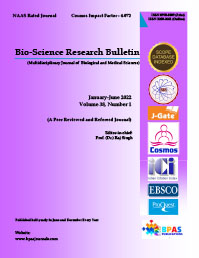Sacred Plants with Medicinal Uses
DOI:
https://doi.org/10.48165/Keywords:
Plants, Rituals, Medicinal, DiseasesAbstract
India is a country of farmers and festivals. On every occasion there is a festival (with various names in different parts of country) with rituals. Many God and Goddess have been worshipped here. Whole plant or plant parts such as twigs, leaves, bark, buds, flowers, fruit, seeds etc have been utilized by peoples during worshipping. This report discussed about eight plant species named as Ficus religiosa, Prosopis cineraria, Emblica officinalis, Mangifera indica, Curcuma longa, Oryza sativa, Hordeum vulgare and Triticum aestivum and its parts utilized in Aurangabad district in religious rituals and ceremonies. These plants also have medicinal values, used for treatment of various diseases.
References
Ananda, R.J. and Kunjani, J. (2000): Indigenous knowledge and uses of medicinal plants by local communities of the Kali Gandaki Watershed Area, Nepal. J Ethnopharmacol, 73, 175-183
Baliga, Manjeshwar Shrinath, Suresh Rao (2019), Hepatoprotective Effects of the Indian Gooseberry (Emblica officinalis Gaertn)
Barreto, J.C., Trevisan, M.T.S., Hull W.E., Erben G., De Brito ES., Pfundstien, B., Wurtele, G., Spiegelhalder B., Owen, R.W. (2008). Characterization and quantitation of polyphenolic compounds in bark, kernel, leaves and peel of mango (Mangifera indica L) Journal of Agricultural and food Chemistry, 56(14, 5599-5610.
Black, J., Green, A., (1992): Gods, Demons and Symbols of Ancient Mesopotamia: An Illustrated Dictionary. The British Museum Press. p-39,
Chidrawar, V.R., Chitmer, H.R., Patel, K. N., Patel, N. J., Richaria, V.R., Dhoraji, N.C., and Vadalia, K.R. (2011). Journal of Young Pharmacists, 3(1), 26-35.
Chopra, R.N., and Chopra, S., (1958): Indigenous Drugs of India. 2nd Ed. Calcutta. Dhurand Sons. p. 606
Dhiman, A. K., (2003). Sacred Plants ofDistrict Haridwar (Uttranchal) and their Medicinal uses. Ad. Plant Sci. 16(II), 377- 384
Dixit, G., (1997). Fire Sacrificial plants, Geobios New Reports,16(8) 47:48
Edwards, S.M., (1922). Tree worship of India. Empire Forestry Journal 1(I) 78-86 10. Garris., Tai, T.H., Coburn, J., Kresovich, S., McCouch, S., (2004): Genetic structure and diversity in Oryza sativa L. Genetics, 169(3), 1631-8
Ghate, V.S., (1998). Plants inP atra Pooja : Notes on their identity and utilization. Ethnobotany, 10, 6-15
Glaszmann, J.C., (1987). Isozymes and classification of Asian rice varieties. Theoretical and Applied Genetics, 74(I), 21-30.
Joshi, P. N., D. C. Bhatt., K. D. Mitallya, S. K. Patel and P.I. Lashkari (2003). Religious trees and their economic importance of Kutchchh District Gujarat, India. Ad. Plant Sci, 16 (II), 399-402.
Kalpana, G., and Rishi, R. B., (2009). Ethnomedicinal Knowledge and healthcare practices among the Tharus of Nawalparasi district in Central Nepal. For Ecol Manage, 257, 2066-72
Kamiyama, M., Shibamoto, T., (2012). Flavonoids with potent antioxidant activity found in young green barley leaves. Journal of Agricultural and Food Chemistry, 60(25), 6260-7.
Kandwal., Manish. K., and Sharma, M.L., (2011). Cynodondactylon (L) Pers: a self treatment grass for dogs. Current Science, 101(5), 619-621
Kumari, Chandresh., (2016). Ethnobotanical studies of medicinal plants of Barabar hills (Jehanabad district) of Bihar. Ph.D. Thesis. M.U. Bodh Gaya
Majupuria, Trilok Chandra., (2009). Religious and useful plants of Nepal and India (medicinal plants and flowers as mentioned in religious myths and legends of Hinduism and Budhhism.
Pandey, B.P., (1989). Sacred Plant of India: Shree Publishing House, New Delhi. 20. Oliver, Bever. B., (1977): Oral hypoglycaemic plants in West Africa. J Ethnopharmacol, 2, 119-127
Ramalingam, S, Logeshwaran., Vellapandian. Chitra., R. Vetrivelan, Venkataramanan., Sukumaran, Evelyn Sharon., (2020). Un-riped (sic) fruit pods of Prosopis cineraria (L.) Druce ameliorates Cisplatin therapy - induced partial testicular atrophy in male Wistar rats. Journal of Ethnopharmacology, 261, 113070
Schultes, R., and Hoffmann, A., (1979). Plants of Gods. McGraw Hill Book Company, New York.
Shad, Mohammadi. Z., Atungulu, G., (2019). Post- harvest kernel discoloration and fungi activity in long- grain hybrid, pureline and medium- grain rice cultivars as influenced by storage environment and antifungal treatment. Journal of Stored Products Research, 81, 91-99
Shah, N.C., (1982). Herbal folk medicines in northern India: J. Ethnopharmacol, 6: 293-301.
Sheetal, A., Bagul, M.S., Prabia, M., and Rajani, M. (2008). Evaluation of free radicals scavenging activity of an Ayurvedic formulation, Panchvankala.
Indian J. Pharm. Sci, 70, 31-38
Singh, A.K., Raghubanshi, A.S., and Singh, J.S., (2002).Medical ethnobotany of the tribals of sonaghati of Sonbhadra district. Uttar Pradesh, India. J. Ethnopharmacol, 81, 31-41
Sinha, B.C., (1979). Tree Worship in Ancient India. Books Today, New Delhi 28. Uddin, S.J., Grice, I.D., and Tirolongo, E.,
(2009): Cytotoxic effects of Bangaladeshi medicinal plant extracts. Evid Based Complement Alternat Med.
Sreedevy, K. and Praseetha, P.K., (2021). Evaluation of Anti-bacterial activity of Dashapushpam in the form of Ghritham. International Journal of Research in Pharmaceutical Sciences, 12(1), 222-227.
Wolfgang and Rudolf (2002). Identification of a new flavanol glucoside from barley (Hordeum vulgare L.) and malt. European Food Research and Technology, 214(5), 388-393.
